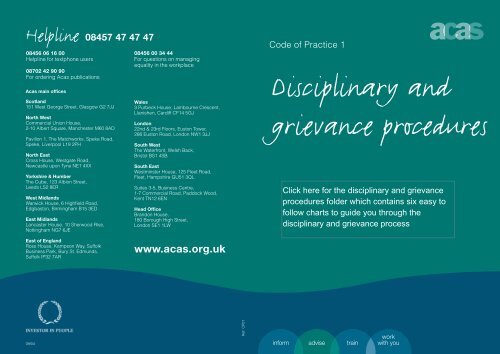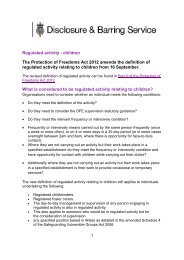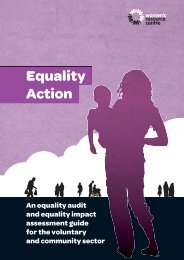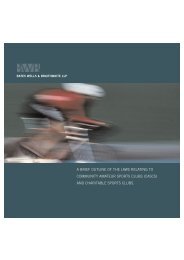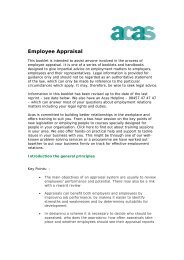Disciplinary & Grievance Procedures - Acas
Disciplinary & Grievance Procedures - Acas
Disciplinary & Grievance Procedures - Acas
You also want an ePaper? Increase the reach of your titles
YUMPU automatically turns print PDFs into web optimized ePapers that Google loves.
Helpline 08457 47 47 4708456 06 16 00Helpline for textphone users08702 42 90 90For ordering <strong>Acas</strong> publications<strong>Acas</strong> main offices08456 00 34 44For questions on managingequality in the workplaceCode of Practice 1<strong>Disciplinary</strong> andScotland151 West George Street, Glasgow G2 7JJNorth WestCommercial Union House,2-10 Albert Square, Manchester M60 8ADPavilion 1, The Matchworks, Speke Road,Speke, Liverpool L19 2PHNorth EastCross House, Westgate Road,Newcastle upon Tyne NE1 4XXYorkshire & HumberThe Cube, 123 Albion Street,Leeds LS2 8ERWest MidlandsWarwick House, 6 Highfi eld Road,Edgbaston, Birmingham B15 3EDEast MidlandsLancaster House, 10 Sherwood Rise,Nottingham NG7 6JEEast of EnglandRoss House, Kempson Way, SuffolkBusiness Park, Bury St. Edmunds,Suffolk IP32 7ARWales3 Purbeck House, Lambourne Crescent,Llanishen, Cardiff CF14 5GJLondon22nd & 23rd Floors, Euston Tower,286 Euston Road, London NW1 3JJSouth WestThe Waterfront, Welsh Back,Bristol BS1 4SBSouth EastWestminster House, 125 Fleet Road,Fleet, Hampshire GU51 3QLSuites 3-5, Business Centre,1-7 Commercial Road, Paddock Wood,Kent TN12 6ENHead OfficeBrandon House,180 Borough High Street,London SE1 1LWwww.acas.org.ukgrievance proceduresRef: CP0109/04
This Code of Practice provides practical guidance to employers, workersand their representatives on:Published by TSO (The Stationery Office) and available from:Onlinewww.tso.co.uk/bookshopMail, Telephone, Fax & E-mailTSOPO Box 29, Norwich, NR3 1GNTelephone orders/General enquiries: 0870 6005522Fax orders: 0870 6005533E-mail: book.orders@tso.co.ukTextphone 0870 240 3701TSO Shops123 Kingsway, London, WC2B 6PQ020 7242 6393 Fax 020 7242 639468-69 Bull Street, Birmingham B4 6AD0121 236 9696 Fax 0121 236 96999-21 Princess Street, Manchester M60 8AS0161 834 7201 Fax 0161 833 0634TSO Accredited Agents(see Yellow Pages)and through good booksellersPublished with the permission of <strong>Acas</strong> on behalf of the Controller of Her Majesty’s Stationery Office.© Crown Copyright 2003All rights reserved.Copyright in the typographical arrangement and design is vested in the Crown. Applications forreproduction should be made in writing to the Copyright Unit, Her Majesty’s Stationery Office,St Clements House, 2-16 Colegate, Norwich NR3 1BQ.First edition Crown Copyright 1991, published by HMSOSecond edition Crown Copyright 1998Third edition Crown Copyright 2003First published 2003ISBN 0 11 703154 2Printed in the United Kingdom for The Stationery Office.Id 135457 c50 5/03 83786416 Arthur Street, Belfast BT1 4GD028 9023 8451 Fax 028 9023 540118-19 High Street, Cardiff CF10 1PT029 2039 5548 Fax 029 2038 434771 Lothian Road, Edinburgh EH3 9AZ0870 606 5566 Fax 0870 606 5588Further copies may also be obtained from <strong>Acas</strong> Publications, Swallow Field Way, Hayes,Middlesex, UB3 1DQ. Tel: 0870 242 9090.The statutory requirements relating to disciplinary andgrievance issues;What constitutes reasonable behaviour when dealing withdisciplinary and grievance issues;Producing and using disciplinary and grievance procedures; andA worker’s right to bring a companion to grievance anddisciplinary hearings.The statutory dismissal, disciplinary and grievance procedures, as setout in the Employment Act 2002, apply only to employees as defined inthe 2002 Act and this term is used throughout sections 1 and 2 of theCode. However, it is good practice to allow all workers access todisciplinary and grievance procedures. The right to be accompaniedapplies to all workers (which includes employees) and this term is usedin section 3 of the Code.A failure to follow any part of this Code does not, in itself, make a personor organisation liable to proceedings. However, employment tribunals willtake the Code into account when considering relevant cases. Similarly,arbitrators appointed by <strong>Acas</strong> to determine relevant cases under the<strong>Acas</strong> Arbitration Scheme will take the Code into account.A failure to follow the statutory disciplinary and grievance procedureswhere they apply may have a number of legal implications which aredescribed in the Code.The Code (from page 2 to page 36) is issued under section 199 of theTrade Union and Labour Relations (Consolidation) Act 1992 and was laidbefore both Houses of Parliament on 17 June 2004. The Code comes intoeffect by order of the Secretary of State on 1 October 2004.More comprehensive, practical, advice and guidance on disciplinary andgrievance procedures is contained in the <strong>Acas</strong> Handbook “Discipline andgrievances at work”which also includes information on the DisabilityDiscrimination Act 1995 and the Data Protection Act 1998. The Handbookcan be obtained from the <strong>Acas</strong> website at www.acas.org.uk. Furtherinformation on the detailed provisions of the statutory disciplinary andgrievance procedures can be found on the Department of Trade andIndustry’s website at www.dti.gov.uk/er.1
1234ContentsSection 1: <strong>Disciplinary</strong> rules and proceduresAt a glance 4Guidance 5• Why have disciplinary rules and procedures? 5• Dealing with disciplinary issues in the workplace 7• What if a grievance is raised during a disciplinary case? 13• Dealing with gross misconduct 14• Dealing with absence from work 14• Dealing with special situations 15• Appeals 15• Keeping records 16• Drawing up disciplinary rules and procedures 17• Further action 20Section 2: <strong>Grievance</strong> proceduresAt a glance 22Guidance 23• Why have grievance procedures? 23• Dealing with grievances in the workplace 23• Raising a grievance 25• <strong>Grievance</strong> meetings 26• Appeals 27• Special considerations 28• Keeping records 28• Drawing up grievance procedures 29Section 3: A worker’s right to be accompaniedAt a glance 32Guidance 33• What is the right to be accompanied? 33• What is a disciplinary hearing? 33• What is a grievance hearing? 33• What is a reasonable request? 34• The companion 34• Applying the right 35Section 4: AnnexesAnnex A: Standard statutory dismissal and disciplinary procedure 38Annex B: Modified statutory dismissal and disciplinary procedure 40Annex C: Standard statutory grievance procedure 41Annex D: Modified statutory grievance procedure 43Annex E: Statutory procedures: exemptions and deemed compliance 44Section 1<strong>Disciplinary</strong> rulesand procedures2 CODE OF PRACTICE 1 – DISCIPLINARY AND GRIEVANCE PROCEDURES3
At a glanceDrawing up disciplinary rules andprocedures• Involve management, employeesand their representatives whereappropriate (Paragraph 52).• Make rules clear and briefand explain their purpose(Paragraph 53).• Explain rules and procedures toemployees and make sure theyhave a copy or ready access to acopy of them (Paragraph 55).Operating disciplinaryprocedures• Establish facts beforetaking action (Paragraph 8).• Deal with cases of minormisconduct or unsatisfactoryperformance informally(Paragraphs 11-12).• For more serious cases, followformal procedures, includinginforming the employee of thealleged misconduct orunsatisfactory performance(Paragraph 13).• Invite the employee to a meetingand inform them of the right tobe accompanied(Paragraph 14-16).• Where performance isunsatisfactory explain to theemployee the improvementrequired, the support that will begiven and when and howperformance will be reviewed(Paragraphs 19-20).• If giving a warning, tell theemployee why and how they needto change, the consequences offailing to improve and that theyhave a right to appeal(Paragraphs 21-22).• If dismissing an employee, tellthem why, when their contract willend and that they can appeal(Paragraph 25).• Before dismissing or takingdisciplinary action other thanissuing a warning, always followthe statutory dismissal anddisciplinary procedure(Paragraphs 26-32).• When dealing with absencesfrom work, find out the reasonsfor the absence before decidingon what action to take.(Paragraph 37).Holding appeals• If the employee wishes toappeal invite them to a meetingand inform the employee of theirright to be accompanied(Paragraphs 44-48).• Where possible, arrange forthe appeal to be dealt with by amore senior manager notinvolved with the earlier decision(Paragraph 46).• Inform the employee aboutthe appeal decision and thereasons for it (Paragraph 48).Records• Keep written records forfuture reference (Paragraph 49).GuidanceWhy have disciplinary rules and procedures?1. <strong>Disciplinary</strong> rules and procedures help to promote orderlyemployment relations as well as fairness and consistency in thetreatment of individuals. <strong>Disciplinary</strong> procedures are also a legalrequirement in certain circumstances (see paragraph 6).2. <strong>Disciplinary</strong> rules tell employees what behaviour employers expectfrom them. If an employee breaks specific rules about behaviour, thisis often called misconduct. Employers use disciplinary proceduresand actions to deal with situations where employees allegedly breakdisciplinary rules. <strong>Disciplinary</strong> procedures may also be used whereemployees don’t meet their employer’s expectations in the way theydo their job. These cases, often known as unsatisfactory performance(or capability), may require different treatment from misconduct, anddisciplinary procedures should allow for this.3. Guidance on how to draw up disciplinary rules and procedures iscontained in paragraphs 52-62.4. When dealing with disciplinary cases, employers need to be awareboth of the law on unfair dismissal and the statutory minimumprocedure contained in the Employment Act 2002 for dismissing ortaking disciplinary action against an employee. Employers must alsobe careful not to discriminate on the grounds of gender, race(including colour, nationality and ethnic or national origins), disability,age, sexual orientation or religion.The law on unfair dismissal5. The law on unfair dismissal requires employers to act reasonablywhen dealing with disciplinary issues. What is classed as reasonablebehaviour will depend on the circumstances of each case, and isultimately a matter for employment tribunals to decide. However,the core principles employers should work to are set out in thebox overleaf. Drawing up and referring to a procedure canhelp employers deal with disciplinary issues in a fair andconsistent manner.14 CODE OF PRACTICE 1 – DISCIPLINARY AND GRIEVANCE PROCEDURES SECTION 1 – DISCIPLINARY RULES AND PROCEDURES 5
Core principles of reasonable behaviour1• Use procedures primarily to help and encourage employees toimprove rather than just as a way of imposing a punishment.• Inform the employee of the complaint against them, and providethem with an opportunity to state their case before decisionsare reached.• Allow employees to be accompanied at disciplinary meetings.• Make sure that disciplinary action is not taken until the facts ofthe case have been established and that the action is reasonablein the circumstances.• Never dismiss an employee for a first disciplinary offence,unless it is a case of gross misconduct.• Give the employee a written explanation for any disciplinary actiontaken and make sure they know what improvement is expected.• Give the employee an opportunity to appeal.• Deal with issues as thoroughly and promptly as possible.• Act consistently.The statutory minimum procedure6. Employers are also required to follow a specific statutory minimumprocedure if they are contemplating dismissing an employee orimposing some other disciplinary penalty that is not suspension onfull pay or a warning. Guidance on this statutory procedure isprovided in paragraphs 26-32. If an employee is dismissed withoutthe employer following this statutory procedure, and makes a claimto an employment tribunal, providing they have the necessaryqualifying service and providing they are not prevented from claimingunfair dismissal by virtue of their age, the dismissal will automaticallybe ruled unfair. The statutory procedure is a minimum requirementand even where the relevant procedure is followed the dismissalmay still be unfair if the employer has not acted reasonably in allthe circumstances.What about small businesses?7. In small organisations it may not be practicable to adopt all thedetailed good practice guidance set out in this Code. Employmenttribunals will take account of an employer’s size and administrativeresources when deciding if it acted reasonably. However, allorganisations regardless of size must follow the minimum statutorydismissal and disciplinary procedures.Dealing with disciplinary issues in the workplace8. When a potential disciplinary matter arises, the employer shouldmake necessary investigations to establish the facts promptly beforememories of events fade. It is important to keep a written record forlater reference. Having established the facts, the employer shoulddecide whether to drop the matter, deal with it informally or arrangefor it to be handled formally. Where an investigatory meeting is heldsolely to establish the facts of a case, it should be made clear to theemployee involved that it is not a disciplinary meeting.9. In certain cases, for example in cases involving gross misconduct,where relationships have broken down or there are risks to anemployer’s property or responsibilities to other parties, considerationshould be given to a brief period of suspension with full pay whilstunhindered investigation is conducted. Such a suspension shouldonly be imposed after careful consideration and should be reviewedto ensure it is not unnecessarily protracted. It should be made clearthat the suspension is not considered a disciplinary action.10. When dealing with disciplinary issues in the workplace employersshould bear in mind that they are required under the DisabilityDiscrimination Act 1995 to make reasonable adjustments to cater foremployees who have a disability, for example providing forwheelchair access if necessary.6 CODE OF PRACTICE 1 – DISCIPLINARY AND GRIEVANCE PROCEDURES SECTION 1 – DISCIPLINARY RULES AND PROCEDURES 7
Informal action11. Cases of minor misconduct or unsatisfactory performance are usuallybest dealt with informally. A quiet word is often all that is required toimprove an employee’s conduct or performance. The informalapproach may be particularly helpful in small firms, where problemscan be dealt with quickly and confidentially. There will, however, besituations where matters are more serious or where an informalapproach has been tried but is not working.12. If informal action does not bring about an improvement, or themisconduct or unsatisfactory performance is considered to be tooserious to be classed as minor, employers should provide employeeswith a clear signal of their dissatisfaction by taking formal action.Formal actionInform the employee of the problem13. The first step in any formal process is to let the employee know inwriting what it is they are alleged to have done wrong. The letter ornote should contain enough information for the individual to be ableto understand both what it is they are alleged to have done wrongand the reasons why this is not acceptable. If the employee hasdifficulty reading, or if English is not their first language, the employershould explain the content of the letter or note to them orally.The letter or note should also invite the individual to a meeting atwhich the problem can be discussed, and it should inform theindividual of their right to be accompanied at the meeting (seesection 3). The employee should be given copies of any documentsthat will be produced at the meeting.Hold a meeting to discuss the problem14. Where possible, the timing and location of the meeting shouldbe agreed with the employee. The length of time between thewritten notification and the meeting should be long enough to allowthe employee to prepare but not so long that memories fade.The employer should hold the meeting in a private location andensure there will be no interruptions.15. At the meeting, the employer should explain the complaint againstthe employee and go through the evidence that has been gathered.The employee should be allowed to set out their case and answer anyallegations that have been made. The employee should also beallowed to ask questions, present evidence, call witnesses and begiven an opportunity to raise points about any information providedby witnesses.16. An employee who cannot attend a meeting should inform theemployer in advance whenever possible. If the employee fails toattend through circumstances outside their control and unforeseeableat the time the meeting was arranged (eg illness) the employer shouldarrange another meeting. A decision may be taken in the employee’sabsence if they fail to attend the re-arranged meeting without goodreason. If an employee’s companion cannot attend on a proposeddate, the employee can suggest another date so long as it isreasonable and is not more than five working days after the dateoriginally proposed by the employer. This five day time limit may beextended by mutual agreement.Decide on outcome and action17. Following the meeting the employer must decide whether disciplinaryaction is justified or not. Where it is decided that no action is justifiedthe employee should be informed. Where it is decided thatdisciplinary action is justified the employer will need to consider whatform this should take. Before making any decision the employershould take account of the employee’s disciplinary and generalrecord, length of service, actions taken in any previous similar case,the explanations given by the employee and – most important of all –whether the intended disciplinary action is reasonable under thecircumstances.18. Examples of actions the employer might choose to take are set out inparagraphs 19-25. It is normally good practice to give employees atleast one chance to improve their conduct or performance beforethey are issued with a final written warning. However, if an employee’smisconduct or unsatisfactory performance – or its continuance – issufficiently serious, for example because it is having, or is likely tohave, a serious harmful effect on the organisation, it may beappropriate to move directly to a final written warning. In cases ofgross misconduct, the employer may decide to dismiss even thoughthe employee has not previously received a warning for misconduct.(Further guidance on dealing with gross misconduct is set out atparagraphs 35-36.)18 CODE OF PRACTICE 1 – DISCIPLINARY AND GRIEVANCE PROCEDURES SECTION 1 – DISCIPLINARY RULES AND PROCEDURES 9
First formal action – unsatisfactory performance19. Following the meeting, an employee who is found to be performingunsatisfactorily should be given a written note setting out:• the performance problem;• the improvement that is required;• the timescale for achieving this improvement;• a review date; and• any support the employer will provide to assist the employee.20. The employee should be informed that the note represents the firststage of a formal procedure and that failure to improve could lead toa final written warning and, ultimately, dismissal. A copy of the noteshould be kept and used as the basis for monitoring and reviewingperformance over a specified period (eg six months).First formal action – misconduct21. Where, following a disciplinary meeting, an employee is found guiltyof misconduct, the usual first step would be to give them a writtenwarning setting out the nature of the misconduct and the change inbehaviour required.22. The employee should be informed that the warning is part of theformal disciplinary process and what the consequences will be of afailure to change behaviour. The consequences could be a finalwritten warning and ultimately, dismissal. The employee should alsobe informed that they may appeal against the decision. A record ofthe warning should be kept, but it should be disregarded fordisciplinary purposes after a specified period (eg six months).23. Guidance on dealing with cases of gross misconduct is provided inparagraphs 35-36.Final written warning24. Where there is a failure to improve or change behaviour in thetimescale set at the first formal stage, or where the offence issufficiently serious, the employee should normally be issued with afinal written warning – but only after they have been given a chanceto present their case at a meeting. The final written warning shouldgive details of, and grounds for, the complaint. It should warn theemployee that failure to improve or modify behaviour may leadto dismissal or to some other penalty, and refer to the right of appeal.The final written warning should normally be disregarded fordisciplinary purposes after a specified period (for example12 months).Dismissal or other penalty25. If the employee’s conduct or performance still fails to improve, thefinal stage in the disciplinary process might be dismissal or (if theemployee’s contract allows it or it is mutually agreed) some otherpenalty such as demotion, disciplinary transfer, or loss of seniority/pay. A decision to dismiss should only be taken by a manager whohas the authority to do so. The employee should be informed as soonas possible of the reasons for the dismissal, the date on which theemployment contract will terminate, the appropriate period of noticeand their right of appeal.26. It is important for employers to bear in mind that before they dismissan employee or impose a sanction such as demotion, loss of seniorityor loss of pay, they must as a minimum have followed the statutorydismissal and disciplinary procedures. The standard statutoryprocedure to be used in almost all cases requires the employer to:Step 1Write to the employee notifying them of the allegations against themand the basis of the allegations and invite them to a meeting to discussthe matter.Step 2Hold a meeting to discuss the allegations – at which the employee hasthe right to be accompanied – and notify the employee of the decision.Step 3If the employee wishes to appeal, hold an appeal meeting at which theemployee has the right to be accompanied – and inform the employeeof the final decision.110 CODE OF PRACTICE 1 – DISCIPLINARY AND GRIEVANCE PROCEDURES SECTION 1 – DISCIPLINARY RULES AND PROCEDURES 11
27. More detail on the statutory standard procedure is set out at Annex A.There is a modified two-step procedure for use in special circumstancesinvolving gross misconduct and details of this are set out at Annex B.Guidance on the modified procedure is contained in paragraph 36.There are a number of situations in which it is not necessary foremployers to use the statutory procedures or where they will have beendeemed to be completed and these are described in Annex E.28. If the employer fails to follow this statutory procedure (where itapplies), and an employee who is qualified to do so makes a claimfor unfair dismissal, the employment tribunal will automatically find thedismissal unfair. The tribunal will normally increase the compensationawarded by 10 per cent, or, where it feels it is just and equitable to doso, up to 50 per cent. Equally, if the employment tribunal finds that anemployee has been dismissed unfairly but has failed to follow theprocedure (for instance they have failed to attend the disciplinarymeeting without good cause), compensation will be reduced by,normally, 10 per cent, or, if the tribunal considers it just and equitableto do so, up to 50 per cent.29. If the tribunal considers there are exceptional circumstances,compensation may be adjusted (up or down) by less than 10 per centor not at all.30. Employers and employees will normally be expected to go through thestatutory dismissal and disciplinary procedure unless they havereasonable grounds to believe that by doing so they might be exposedto a significant threat, such as violent, abusive or intimidating behaviour,or they will be harassed. There will always be a certain amount of stressand anxiety for both parties when dealing with any disciplinary case,but this exemption will only apply where the employer or employeereasonably believes that they would come to some serious physical ormental harm; their property or some third party is threatened or theother party has harassed them and this may continue.31. Equally, the statutory procedure does not need to be followed ifcircumstances beyond the control of either party prevent one ormore steps being followed within a reasonable period. This willsometimes be the case where there is a long-term illness or a longperiod of absence abroad but, in the case of employers, whereverpossible they should consider appointing another manager to deal withthe procedure.32. Where an employee fails to attend a meeting held as part of thestatutory discipline procedure without good reason the statutoryprocedure comes to an end. In those circumstances the employee’scompensation may be reduced if they bring a successful complaintbefore an employment tribunal. If the employee does have a goodreason for non-attendance, the employer must re-arrange themeeting. If the employee does not attend the second meeting forgood reason the employer need not arrange a third meeting but therewill be no adjustment of compensation.What if a grievance is raised during a disciplinary case?33. In the course of a disciplinary process, an employee might raise agrievance that is related to the case. If this happens, the employershould consider suspending the disciplinary procedure for a shortperiod while the grievance is dealt with. Depending on the nature ofthe grievance, the employer may need to consider bringing in anothermanager to deal with the disciplinary process. In small organisationsthis may not be possible, and the existing manager should deal withthe case as impartially as possible.34. Where the action taken or contemplated by the employer is dismissalthe statutory grievance procedure does not apply. Where the actiontaken or contemplated is paid suspension or a warning the statutorygrievance procedure and not the dismissal and disciplinaryprocedure applies to any grievance. However, where the employertakes, or is contemplating other action short of dismissal and assertsthat the reason for the action is conduct or capability related, thestatutory grievance procedure does not apply unless the grievance isthat the action amounts, or would amount, to unlawful discrimination,or that the true reason for the action is not the reason given by theemployer. In those cases the employee must have raised a writtengrievance in accordance with the statutory grievance procedurebefore presenting any complaint to an employment tribunal about theissue raised by the grievance. However, if the written grievance israised before any disciplinary appeal meeting, the rest of thegrievance procedure does not have to be followed, although theemployer may use the appeal meeting to discuss the grievance.112 CODE OF PRACTICE 1 – DISCIPLINARY AND GRIEVANCE PROCEDURES SECTION 1 – DISCIPLINARY RULES AND PROCEDURES 13
Dealing with gross misconduct35. If an employer considers an employee guilty of gross misconduct,and thus potentially liable for summary dismissal, it is still importantto establish the facts before taking any action. A short period ofsuspension with full pay may be helpful or necessary, although itshould only be imposed after careful consideration and should bekept under review. It should be made clear to the employee thatthe suspension is not a disciplinary action and does not involveany prejudgement.36. It is a core principle of reasonable behaviour that employers shouldgive employees the opportunity of putting their case at a disciplinarymeeting before deciding whether to take action. This principle appliesas much to cases of gross misconduct as it does to ordinary cases ofmisconduct or unsatisfactory performance. There may however besome very limited cases where despite the fact that an employer hasdismissed an employee immediately without a meeting anemployment tribunal will, very exceptionally, find the dismissal to befair. To allow for these cases there is a statutory modified procedureunder which the employer is required to write to the employee afterthe dismissal setting out the reasons for the dismissal and to hold anappeal meeting, if the employee wants one. The statutory procedurethat must be followed by employers in such cases is set out in AnnexB. If an employer fails to follow this procedure and the case goes totribunal, the dismissal will be found to be automatically unfair.Dealing with absence from work37. When dealing with absence from work, it is important to determine thereasons why the employee has not been at work. If there is noacceptable reason, the matter should be treated as a conduct issueand dealt with as a disciplinary matter.38. If the absence is due to genuine (including medically certified)illness, the issue becomes one of capability, and the employer shouldtake a sympathetic and considerate approach. When thinking abouthow to handle these cases, it is helpful to consider:• how soon the employee’s health and attendance will improve;• whether alternative work is available;• the effect of the absence on the organisation;• how similar situations have been handled in the past; and• whether the illness is a result of disability in which case theprovisions of the Disability Discrimination Act 1995 will apply.39. The impact of long-term absences will nearly always be greater onsmall organisations, and they may be entitled to act at an earlierstage than large organisations.40. In cases of extended sick leave both statutory and contractual issueswill need to be addressed and specialist advice may be necessary.Dealing with special situationsIf the full procedure is not immediately available41. Special arrangements might be required for handling disciplinarymatters among nightshift employees, employees in isolated locationsor depots, or others who may be difficult to reach. Nevertheless theappropriate statutory procedure must be followed where it applies.Trade union representatives42. <strong>Disciplinary</strong> action against a trade union representative can lead to aserious dispute if it is seen as an attack on the union’s functions.Normal standards apply but, if disciplinary action is considered, thecase should be discussed, after obtaining the employee’s agreement,with a senior trade union representative or permanent union official.Criminal charges or convictions not related to employment43. If an employee is charged with, or convicted of, a criminal offencenot related to work, this is not in itself reason for disciplinary action.The employer should establish the facts of the case and considerwhether the matter is serious enough to warrant starting thedisciplinary procedure. The main consideration should be whetherthe offence, or alleged offence, is one that makes the employeeunsuitable for their type of work. Similarly, an employee should not bedismissed solely because they are absent from work as a result ofbeing remanded in custody.Appeals44. Employees who have had disciplinary action taken against themshould be given the opportunity to appeal. It is useful to set a timelimit for asking for an appeal – five working days is usually enough.114 CODE OF PRACTICE 1 – DISCIPLINARY AND GRIEVANCE PROCEDURES SECTION 1 – DISCIPLINARY RULES AND PROCEDURES 15
45. An employee may choose to appeal for example because:• they think a finding or penalty is unfair;• new evidence comes to light; or• they think the disciplinary procedure was not used correctly.It should be noted that the appeal stage is part of the statutoryprocedure and if the employee pursues an employment tribunal claimthe tribunal may reduce any award of compensation if the employeedid not exercise the right of appeal.46. As far as is reasonably practicable a more senior manager notinvolved with the case should hear the appeal. In small organisations,even if a more senior manager is not available, another managershould hear the appeal, if possible. If that is not an option, the personoverseeing the case should act as impartially as possible. Recordsand notes of the original disciplinary meeting should be madeavailable to the person hearing the appeal.47. The employers should contact the employee with appealarrangements as soon as possible, and inform them of their statutoryright to be accompanied at the appeal meeting.48. The manager must inform the employee about the appeal decision,and the reasons for it, as soon as possible. They should also confirmthe decision in writing. If the decision is the final stage of theorganisation’s appeals procedure, the manager should make thisclear to the employee.Keeping records49. It is important, and in the interests of both employers and employees,to keep written records during the disciplinary process. Recordsshould include:• the complaint against the employee;• the employee’s defence;• findings made and actions taken;• the reason for actions taken;• whether an appeal was lodged;• the outcome of the appeal;• any grievances raised during the disciplinary procedure; and• subsequent developments.50. Records should be treated as confidential and be kept no longer thannecessary in accordance with the Data Protection Act 1998. This Actgives individuals the right to request and have access to certainpersonal data.51. Copies of meeting records should be given to the employee includingcopies of any formal minutes that may have been taken. In certaincircumstances (for example to protect a witness) the employer mightwithhold some information.Drawing up disciplinary rules and procedures52. Management is responsible for maintaining and setting standards ofperformance in an organisation and for ensuring that disciplinaryrules and procedures are in place. Employers are legally required tohave disciplinary procedures. It is good practice to involveemployees (and, where appropriate, their representatives) whenmaking or changing rules and procedures, so that everyone affectedby them understands them.Rules53. When making rules, the aim should be to specify those that arenecessary for ensuring a safe and efficient workplace and formaintaining good employment relations.54. It is unlikely that any set of rules will cover all possible disciplinaryissues, but rules normally cover:• bad behaviour, such as fighting or drunkenness;• unsatisfactory work performance;• harassment or victimisation;• misuse of company facilities (for example email and internet);• poor timekeeping;• unauthorised absences; and• repeated or serious failure to follow instructions.116 CODE OF PRACTICE 1 – DISCIPLINARY AND GRIEVANCE PROCEDURES SECTION 1 – DISCIPLINARY RULES AND PROCEDURES 17
55. Rules should be specific, clear and recorded in writing. They alsoneed to be readily available to employees, for instance on anoticeboard or, in larger organisations, in a staff handbook or on theintranet. Management should do all they can to ensure that everyemployee knows and understands the rules, including thoseemployees whose first language is not English or who have troublereading. This is often best done as part of an induction process.56. Employers should inform employees of the likely consequences ofbreaking disciplinary rules. In particular, they should list examples ofacts of gross misconduct that may warrant summary dismissal.57. Acts which constitute gross misconduct are those resulting in aserious breach of contractual terms and are best decided byorganisations in the light of their own particular circumstances.However, examples of gross misconduct might include:• theft or fraud;• physical violence or bullying;• deliberate and serious damage to property;• serious misuse of an organisation’s property or name;• deliberately accessing internet sites containing pornographic,offensive or obscene material;• serious insubordination;• unlawful discrimination or harassment;• bringing the organisation into serious disrepute;• serious incapability at work brought on by alcohol or illegal drugs;• causing loss, damage or injury through serious negligence;• a serious breach of health and safety rules; and• a serious breach of confidence.<strong>Procedures</strong>58. <strong>Disciplinary</strong> procedures should not be seen primarily as a means ofimposing sanctions but rather as a way of encouraging improvementamongst employees whose conduct or performance is unsatisfactory.Some organisations may prefer to have separate procedures fordealing with issues of conduct and capability. Large organisationsmay also have separate procedures to deal with other issues such asharassment and bullying.59. When drawing up and applying procedures employers should alwaysbear in mind the requirements of natural justice. This means thatemployees should be given the opportunity of a meeting withsomeone who has not been involved in the matter. They should beinformed of the allegations against them, together with the supportingevidence, in advance of the meeting. Employees should be given theopportunity to challenge the allegations before decisions are reachedand should be provided with a right of appeal.60. Good disciplinary procedures should:• be put in writing;• say to whom they apply;• be non-discriminatory;• allow for matters to be dealt without undue delay;• allow for information to be kept confidential;• tell employees what disciplinary action might be taken;• say what levels of management have the authority totake disciplinary action;• require employees to be informed of the complaintsagainst them and supporting evidence, before a meeting;• give employees a chance to have their say beforemanagement reaches a decision;• provide employees with the right to be accompanied;• provide that no employee is dismissed for a first breachof discipline, except in cases of gross misconduct;• require management to investigate fully before anydisciplinary action is taken;• ensure that employees are given an explanation forany sanction; and• allow employees to appeal against a decision.118 CODE OF PRACTICE 1 – DISCIPLINARY AND GRIEVANCE PROCEDURES SECTION 1 – DISCIPLINARY RULES AND PROCEDURES 19
61. It is important to ensure that everyone in an organisation understandsthe disciplinary procedures including the statutory requirements. Insmall firms this is best done by making sure all employees haveaccess to a copy of the procedures, for instance on a noticeboard,and by taking a few moments to run through the procedures with theemployee. In large organisations formal training for those who useand operate the procedures may be appropriate.Section 2<strong>Grievance</strong> <strong>Procedures</strong>Further action62. It is sensible to keep rules and procedures under review to make surethey are always relevant and effective. New or additional rules shouldonly be introduced after reasonable notice has been given to allemployees and any employee representatives have been consulted.20 CODE OF PRACTICE 1 – DISCIPLINARY AND GRIEVANCE PROCEDURES 21
At a glanceGuidanceDrawing up grievanceprocedures• Involve management,employees and theirrepresentatives whereappropriate (Paragraph 90).• Explain procedures toemployees and make sure theyhave a copy or ready access toa copy of them (Paragraph 94).Operating grievance procedures• Many grievances can be settledinformally with line managers(Paragraph 67).• Employees should raise formalgrievances with management(Paragraph 73).• Invite the employee to ameeting and inform them aboutthe right to be accompanied(Paragraph 77).• Give the employee anopportunity to have their say atthe meeting (Paragraph 78).Appeals• If possible, a more seniormanager should handle theappeal (Paragraph 82).• Tell the employee they have theright to be accompanied(Paragraph 82).• The senior manager shouldrespond to the grievance inwriting after the appeal and tellthe employee if it is the finalstage in the grievanceprocedure (Paragraph 83).Records• Written records should bekept for future reference(Paragraph 87).Why have grievance procedures?63. <strong>Grievance</strong>s are concerns, problems or complaints that employeesraise with their employers.64. <strong>Grievance</strong> procedures are used by employers to deal withemployees’ grievances.65. <strong>Grievance</strong> procedures allow employers to deal with grievances fairly,consistently and speedily. Employers must have procedures availableto employees so that their grievances can be properly considered.66. Guidance on drawing up grievance procedures is set out inparagraphs 90-95.Dealing with grievances in the workplace67. Employees should aim to resolve most grievances informally withtheir line manager. This has advantages for all workplaces,particularly where there might be a close personal relationshipbetween a manager and an employee. It also allows for problemsto be resolved quickly.68. If a grievance cannot be settled informally, the employee shouldraise it formally with management. There is a statutory grievanceprocedure that employees must invoke if they wish subsequently touse the grievance as the basis of certain applications to anemployment tribunal.2• Write with a response within areasonable time and inform theemployee of their right to appeal(Paragraph 81).22 CODE OF PRACTICE 1 – DISCIPLINARY AND GRIEVANCE PROCEDURES SECTION 2 – GRIEVANCE PROCEDURES 23
69. Under the standard statutory procedure, employees must:Step 1Inform the employer of their grievance in writing.Step 2Be invited by the employer to a meeting to discuss the grievancewhere the right to be accompanied will apply and be notified in writingof the decision. The employee must take all reasonable steps toattend this meeting.Step 3Be given the right to an appeal meeting if they feel the grievance hasnot been satisfactorily resolved and be notified of the final decision.More detail on the standard statutory procedure is set out in Annex C.70. There are certain occasions when it is not necessary to follow thestatutory procedure for example, if the employee is raising a concernin compliance with the Public Interest Disclosure Act or a grievance israised on behalf of at least two employees by an appropriaterepresentative such as an official of an independent trade union.A full list of exemptions is set out in Annex E.71. It is important that employers and employees follow the statutorygrievance procedure where it applies. The employee should(subject to the exemptions described in Annex E) at least haveraised the grievance in writing and waited 28 days before presentingany tribunal claim relating to the matter. A premature claim will beautomatically rejected by the tribunal although (subject to specialtime limit rules) it may be presented again once the writtengrievance has been raised. Furthermore if a grievance comes beforean employment tribunal and either party has failed to follow theprocedure then the tribunal will normally adjust any award by10 per cent or, where it feels it just and equitable to do so, by upto 50 per cent, depending on which party has failed to follow theprocedure. In exceptional cases compensation can be adjusted byless than 10 per cent or not at all.72. Wherever possible a grievance should be dealt with before anemployee leaves employment. A statutory grievance procedure(“the modified grievance procedure” described in Annex D),however, applies where an employee has already left employment, thestandard procedure has not been commenced or completed beforethe employee left employment and both parties agree in writing that itshould be used instead of the standard statutory procedure. Under themodified procedure the employee should write to the employer settingout the grievance as soon as possible after leaving employment andthe employer must write back setting out its response.Raising a grievance73. Employees should normally raise a grievance with their line managerunless someone else is specified in the organisation’s procedure. Ifthe complaint is against the person with whom the grievance wouldnormally be raised the employee can approach that person’smanager or another manager in the organisation. In small businesseswhere this is not possible, the line manager should hear thegrievance and deal with it as impartially as possible.74. Managers should deal with all grievances raised, whether or not thegrievance is presented in writing. However, employees need to beaware that if the statutory procedure applies, they will notsubsequently be able to take the case to an employment tribunalunless they have first raised a grievance in writing and waited afurther 28 days before presenting the tribunal claim.75. Setting out a grievance in writing is not easy – especially for thoseemployees whose first language is not English or who have difficultyexpressing themselves on paper. In these circumstances theemployee should be encouraged to seek help for example from awork colleague, a trade union or other employee representative.Under the Disability Discrimination Act 1995 employers are requiredto make reasonable adjustments which may include assistingemployees to formulate a written grievance if they are unable to do sothemselves because of a disability.76. In circumstances where a grievance may apply to more than oneperson and where a trade union is recognised it may be appropriatefor the problem to be resolved through collective agreementsbetween the trade union(s) and the employer.224 CODE OF PRACTICE 1 – DISCIPLINARY AND GRIEVANCE PROCEDURES SECTION 2 – GRIEVANCE PROCEDURES 25
<strong>Grievance</strong> meetings77. On receiving a formal grievance, a manager should invite theemployee to a meeting as soon as possible and inform them that theyhave the right to be accompanied. It is good practice to agree a timeand place for the meeting with the employee. Small organisationsmight not have private meeting rooms, but it is important that themeeting is not interrupted and that the employee feels their grievanceis being treated confidentially. If an employee’s companion cannotattend on a proposed date, the employee can suggest another dateso long as it is reasonable and is not more than five working daysafter the date originally proposed by the employer. This five day timelimit may be extended by mutual agreement.78. The employee should be allowed to explain their complaint and sayhow they think it should be settled. If the employer reaches a point inthe meeting where they are not sure how to deal with the grievance orfeel that further investigation is necessary the meeting should beadjourned to get advice or make further investigation. This might beparticularly useful in small organisations that lack experience ofdealing with formal grievances. The employer should give thegrievance careful consideration before responding.79. Employers and employees will normally be expected to go throughthe statutory grievance procedures unless they have reasonablegrounds to believe that by doing so they might be exposed to asignificant threat, such as violent, abusive or intimidating behaviour,or they will be harassed. There will always be a certain amount ofstress and anxiety for both parties when dealing with grievancecases, but this exemption will only apply where the employer oremployee reasonably believes that they would come to someserious physical or mental harm; their property or some third partyis threatened or the other party has harassed them and thismay continue.80. Equally, the statutory procedure does not need to be followed ifcircumstances beyond the control of either party prevent one or moresteps being followed within a reasonable period. This will sometimesbe the case where there is a long-term illness or a long period ofabsence abroad but wherever possible the employer should considerappointing another manager to deal with the procedure.81. The employer should respond in writing to the employee’s grievancewithin a reasonable time and should let the employee know that theycan appeal against the employer’s decision if they are not satisfiedwith it. What is considered reasonable will vary from organisation toorganisation, but five working days is normally long enough. If it is notpossible to respond within five working days the employee should begiven an explanation for the delay and told when a response can beexpected.Appeals82. If an employee informs the employer that they are unhappy with thedecision after a grievance meeting, the employer should arrange anappeal. It should be noted that the appeal stage is part of thestatutory procedure and if the employee pursues an employmenttribunal claim the tribunal may reduce any award of compensation ifthe employee did not exercise the right of appeal. As far as isreasonably practicable the appeal should be with a more seniormanager than the one who dealt with the original grievance. In smallorganisations, even if there is no more senior manager available,another manager should, if possible, hear the appeal. If that is not anoption, the person overseeing the case should act as impartially aspossible. At the same time as inviting the employee to attend theappeal, the employer should remind them of their right to beaccompanied at the appeal meeting.83. As with the first meeting, the employer should write to the employeewith a decision on their grievance as soon as possible. They shouldalso tell the employee if the appeal meeting is the final stage of thegrievance procedure.84. In large organisations it is good practice to allow a further appealto a higher level of management, such as a director. However,in smaller firms the first appeal will usually mark the end of thegrievance procedure.226 CODE OF PRACTICE 1 – DISCIPLINARY AND GRIEVANCE PROCEDURES SECTION 2 – GRIEVANCE PROCEDURES 27
Special considerations85. Complaints about discrimination, bullying and harassment in theworkplace are sensitive issues, and large organisations often haveseparate grievance procedures for dealing with these. It is importantthat these procedures meet the statutory minimum requirements.86. Organisations may also wish to consider whether they needa whistleblowing procedure in the light of the Public InterestDisclosure Act 1998. This Act provides protection to employeeswho raise concerns about certain kinds of wrongdoing inaccordance with its procedures.Keeping records87. It is important, and in the interests of both employer and employee,to keep written records during the grievance process. Recordsshould include:• the nature of the grievance raised;• a copy of the written grievance;• the employer’s response;• action taken;• reasons for action taken;• whether there was an appeal and, if so, the outcome; and• subsequent developments.88. Records should be treated as confidential and kept in accordancewith the Data Protection Act 1998, which gives individuals the right torequest and have access to certain personal data.89. Copies of meeting records should be given to the employeeincluding any formal minutes that may have been taken. In certaincircumstances (for example to protect a witness) the employermight withhold some information.Drawing up grievance procedures90. When employers draw up grievance procedures, it pays to involveeverybody they will affect, including managers, employees and,where appropriate, their representatives.91. <strong>Grievance</strong> procedures should make it easy for employees to raiseissues with management and should:• be simple and put in writing;• enable an employee’s line manager to deal informally with agrievance, if possible;• keep proceedings confidential; and• allow the employee to have a companion at meetings.92. Issues that may cause grievances include:• terms and conditions of employment;• health and safety;• work relations;• bullying and harassment;• new working practices;• working environment;• organisational change; and• equal opportunities.93. Where separate procedures exist for dealing with grievances onparticular issues (for example, harassment and bullying) these shouldbe used instead of the normal grievance procedure.228 CODE OF PRACTICE 1 – DISCIPLINARY AND GRIEVANCE PROCEDURES SECTION 2 – GRIEVANCE PROCEDURES 29
94. It’s important to ensure that everyone in the organisation understandsthe grievance procedures including the statutory requirements andthat, if necessary, supervisors, managers and employeerepresentatives are trained in their use. Employees must be given acopy of the procedures or have ready access to them, for instance ona noticeboard. Large organisations can include them with disciplinaryprocedures as part of an induction process.95. Take the time to explain the detail of grievance procedures toemployees. This is particularly useful for people who do not speakEnglish very well or who have difficulty with reading.Section 3A worker’s right tobe accompanied30 CODE OF PRACTICE 1 – DISCIPLINARY AND GRIEVANCE PROCEDURES 31
At a glanceGuidanceThe right to be accompanied• All workers have the right tobe accompanied at adisciplinary or grievancehearing (Paragraph 96).• Workers must make areasonable request to theemployer if they want to beaccompanied (Paragraph 96).• <strong>Disciplinary</strong> hearings, for thesepurposes, include meetingswhere either disciplinary actionsor some other actions might betaken against the worker.Appeal hearings are alsocovered (Paragraphs 97-99).• <strong>Grievance</strong> hearings aredefined as meetings where anemployer deals with a worker’scomplaint about a duty owedto them by the employer(Paragraphs 100-102).The companion• The companion can be a fellowworker or a union official(Paragraph 104).• Nobody has to accept aninvitation to act as a companion(Paragraph 107).• Fellow workers who are actingas companions can take paidtime off to prepare for and go toa hearing (Paragraph 109).Applying the right• Agree a suitable date with theworker and the companion(Paragraph 110).• The worker should tell theemployer who the chosencompanion is (Paragraph 112).• The companion can have a sayat the hearing but cannotanswer questions for the worker(Paragraph 113-114).• Do not disadvantage workerswho have applied the right,or their companions(Paragraph 116).What is the right to be accompanied?96. Workers have a statutory right to be accompanied by a fellow workeror trade union official where they are required or invited by theiremployer to attend certain disciplinary or grievance hearings.They must make a reasonable request to their employer to beaccompanied. Further guidance on what is a reasonable request andwho can accompany a worker appears at paragraphs 103-109.What is a disciplinary hearing?97. For the purposes of this right, disciplinary hearings are defined asmeetings that could result in:• a formal warning being issued to a worker (ie a warning that will beplaced on the worker’s record);• the taking of some other disciplinary action (such as suspensionwithout pay, demotion or dismissal) or other action; or• the confirmation of a warning or some other disciplinary action(such as an appeal hearing).98. The right to be accompanied will also apply to any disciplinarymeetings held as part of the statutory dismissal and disciplinaryprocedures. This includes any meetings held after an employee hasleft employment.99. Informal discussions or counselling sessions do not attract the rightto be accompanied unless they could result in formal warnings orother actions. Meetings to investigate an issue are not disciplinaryhearings. If it becomes clear during the course of such a meeting thatdisciplinary action is called for, the meeting should be ended and aformal hearing arranged at which the worker will have the right to beaccompanied.3What is a grievance hearing?100. For the purposes of this right, a grievance hearing is a meeting atwhich an employer deals with a complaint about a duty owed bythem to a worker, whether the duty arises from statute or commonlaw (for example contractual commitments).32 CODE OF PRACTICE 1 – DISCIPLINARY AND GRIEVANCE PROCEDURES SECTION 3 – A WORKER’S RIGHT TO BE ACCOMPANIED 33
101. For instance, an individual’s request for a pay rise is unlikely to fallwithin the definition, unless a right to an increase is specificallyprovided for in the contract or the request raises an issue aboutequal pay. Equally, most employers will be under no legal duty toprovide their workers with car parking facilities, and a grievanceabout such facilities would carry no right to be accompanied at ahearing by a companion. However, if a worker were disabled andneeded a car to get to and from work, they probably would beentitled to a companion at a grievance hearing, as an issue mightarise as to whether the employer was meeting its obligations underthe Disability Discrimination Act 1995.102. The right to be accompanied will also apply to any meetings held aspart of the statutory grievance procedures. This includes anymeetings after the employee has left employment.What is a reasonable request?103. Whether a request for a companion is reasonable will depend on thecircumstances of the individual case and, ultimately, it is a matter forthe courts and tribunals to decide. However, when workers arechoosing a companion, they should bear in mind that it would not bereasonable to insist on being accompanied by a colleague whosepresence would prejudice the hearing or who might have a conflictof interest. Nor would it be reasonable for a worker to ask to beaccompanied by a colleague from a geographically remote locationwhen someone suitably qualified was available on site. The requestto be accompanied does not have to be in writing.The companion104. The companion may be:• a fellow worker (ie another of the employer’s workers);• an official employed by a trade union, or a lay trade union official,as long as they have been reasonably certified in writing by theirunion as having experience of, or having received training in, actingas a worker’s companion at disciplinary or grievance hearings.Certification may take the form of a card or letter.105. Some workers may, however, have additional contractual rights to beaccompanied by persons other than those listed above (for instancea partner, spouse or legal representative). If workers are disabled,employers should consider whether it might be reasonable to allowthem to be accompanied because of their disability.106. Workers may ask an official from any trade union to accompanythem at a disciplinary or grievance hearing, regardless of whetherthe union is recognised or not. However, where a union isrecognised in a workplace, it is good practice for workers to ask anofficial from that union to accompany them.107. Fellow workers or trade union officials do not have to accept arequest to accompany a worker, and they should not be pressurisedto do so.108. Trade unions should ensure that their officials are trained in therole of acting as a worker’s companion. Even when a trade unionofficial has experience of acting in the role, there may still be a needfor periodic refresher training.109. A worker who has agreed to accompany a colleague employedby the same employer is entitled to take a reasonable amount ofpaid time off to fulfil that responsibility. This should cover thehearing and it is also good practice to allow time for the companionto familiarise themselves with the case and confer with the workerbefore and after the hearing. A lay trade union official is permittedto take a reasonable amount of paid time off to accompany a workerat a hearing, as long as the worker is employed by the sameemployer. In cases where a lay official agrees to accompany aworker employed by another organisation, time off is a matter foragreement by the parties concerned.Applying the right110. Where possible, the employer should allow a companion to have asay in the date and time of a hearing. If the companion cannotattend on a proposed date, the worker can suggest an alternativetime and date so long as it is reasonable and it is not more than fiveworking days after the original date.111. In the same way that employers should cater for a worker’s disabilityat a disciplinary or grievance hearing, they should also cater for acompanion’s disability, for example providing for wheelchair accessif necessary.334 CODE OF PRACTICE 1 – DISCIPLINARY AND GRIEVANCE PROCEDURES SECTION 3 – A WORKER’S RIGHT TO BE ACCOMPANIED 35
112. Before the hearing takes place, the worker should tell the employerwho they have chosen as a companion. In certain circumstances(for instance when the companion is an official of a non-recognisedtrade union) it can be helpful for the companion and employer tomake contact before the hearing.113. The companion should be allowed to address the hearing in order to:• put the worker’s case• sum up the worker’s case• respond on the worker’s behalf to any view expressed atthe hearing.Section 4Annexes114. The companion can also confer with the worker during the hearing.It is good practice to allow the companion to participate as fully aspossible in the hearing, including asking witnesses questions. Thecompanion has no right to answer questions on the worker’s behalf,or to address the hearing if the worker does not wish it, or to preventthe employer from explaining their case.115. Workers whose employers fail to comply with a reasonable requestto be accompanied may present a complaint to an employmenttribunal. Workers may also complain to a tribunal if employers fail tore-arrange a hearing to a reasonable date proposed by the workerwhen a companion cannot attend on the date originally proposed.The tribunal may order compensation of up to two weeks’ pay. Thiscould be increased if, in addition, the tribunal finds that the workerhas been unfairly dismissed.116. Employers should be careful not to disadvantage workers for usingtheir right to be accompanied or for being companions, as this isagainst the law and could lead to a claim to an employment tribunal.36 CODE OF PRACTICE 1 – DISCIPLINARY AND GRIEVANCE PROCEDURES 37
Annex A: Standard statutorydismissal and disciplinary procedure(This is a summary of the statutory procedure which is setout in full in Schedule 2 to the Employment Act 2002.)This procedure applies to disciplinary action short of dismissal (excludingoral and written warnings and suspension on full pay) based on eitherconduct or capability. It also applies to dismissals (except forconstructive dismissals) including dismissals on the basis of conduct,capability, expiry of a fixed-term contract, redundancy and retirement.However, it does not apply in certain kinds of excepted cases that aredescribed in Annex E.Step 1Statement of grounds for action and invitation to meeting• The employer must set out in writing the employee’s allegedconduct or characteristics, or other circumstances, which lead themto contemplate dismissing or taking disciplinary action against theemployee.• The employer must send the statement or a copy of it to theemployee and invite the employee to attend a meeting to discussthe matter.Step 2The meeting• The meeting must take place before action is taken, except in thecase where the disciplinary action consists of suspension.• The meeting must not take place unless:i) the employer has informed the employee what the basis wasfor including in the statement under Step 1 the ground orgrounds given in it; andii) the employee has had a reasonable opportunity toconsider their response to that information.• The employee must take all reasonable steps to attend the meeting.• After the meeting, the employer must inform the employee of theirdecision and notify them of the right to appeal against the decisionif they are not satisfied with it.• Employees have the right to be accompanied at the meeting (seesection 3).Step 3Appeal• If the employee wishes to appeal, they must inform the employer.• If the employee informs the employer of their wish to appeal,the employer must invite them to attend a further meeting.• The employee must take all reasonable steps to attend the meeting.• The appeal meeting need not take place before the dismissal ordisciplinary action takes effect.• Where reasonably practicable, the appeal should be dealt with bya more senior manager than attended the first meeting (unless themost senior manager attended that meeting).• After the appeal meeting, the employer must inform the employeeof their final decision.• Employees have the right to be accompanied at the appealmeeting (see section 3).438 CODE OF PRACTICE 1 – DISCIPLINARY AND GRIEVANCE PROCEDURES SECTION 4 – ANNEXES 39
Annex B: Modified statutorydismissal and disciplinary procedure(This is a summary of the statutory procedure which is setout in full in Schedule 2 to the Employment Act 2002.)Step 1Statement of grounds for action• The employer must set out in writing:i) the employee’s alleged misconduct which has led tothe dismissal;ii) the reasons for thinking at the time of the dismissal thatthe employee was guilty of the alleged misconduct; andiii) the employee’s right of appeal against dismissal.• The employer must send the statement or a copy of it tothe employee.Step 2Appeal• If the employee does wish to appeal, they must inform the employer.• If the employee informs the employer of their wish to appeal, theemployer must invite them to attend a meeting.• The employee must take all reasonable steps to attend the meeting.• After the appeal meeting, the employer must inform the employee oftheir final decision.• Where reasonably practicable the appeal should be dealt with by amore senior manager not involved in the earlier decision to dismiss.• Employees have the right to be accompanied at the appealmeeting (see section 3).Annex C: Standard statutorygrievance procedure(This is a summary of the statutory procedure which is setout in full in Schedule 2 to the Employment Act 2002.)Step 1Statement of grievance• The employee must set out the grievance in writing and send thestatement or a copy of it to the employer.Step 2Meeting• The employer must invite the employee to attend a meeting todiscuss the grievance.• The meeting must not take place unless:i) the employee has informed the employer what the basis for thegrievance was when they made the statement under Step 1; andii) the employer has had a reasonable opportunity to consider theirresponse to that information;• The employee must take all reasonable steps to attend the meeting.• After the meeting, the employer must inform the employee of theirdecision as to their response to the grievance and notify them of theright of appeal against the decision if they are not satisfied with it.• Employees have the right to be accompanied at the meeting(see section 3).440 CODE OF PRACTICE 1 – DISCIPLINARY AND GRIEVANCE PROCEDURES SECTION 4 – ANNEXES 41
Step 3Appeal• If the employee does wish to appeal, they must inform the employer.• If the employee informs the employer of their wish to appeal, theemployer must invite them to attend a further meeting.• The employee must take all reasonable steps to attend the meeting.• After the appeal meeting, the employer must inform the employee oftheir final decision.• Where reasonably practicable, the appeal should be dealt with by amore senior manager than attended the first meeting (unless themost senior manager attended that meeting).• Employees have the right to be accompanied at the appeal meeting(see section 3).Annex D: Modified statutorygrievance procedure(This is a summary of the statutory procedure which is setout in full in Schedule 2 to the Employment Act 2002.)Step 1Statement of grievance• The employee must set out in writing:i) the grievance; andii) the basis for it.• The employee must send the statement or a copy of itto the employer.4Step 2Response• The employer must set out their response in writing and sendthe statement or a copy of it to the employee.42 CODE OF PRACTICE 1 – DISCIPLINARY AND GRIEVANCE PROCEDURES SECTION 4 – ANNEXES 43
Annex E: Statutory <strong>Procedures</strong>:Exemptions and Deemed ComplianceThe Employment Act 2002 (Dispute Resolution) Regulations 2004 containdetailed provisions about the application of the Statutory DisputeResolution <strong>Procedures</strong>. This Annex summarises the particular provisionsof the 2004 Regulations which describe:(a) certain situations in which the statutory procedures will not applyat all; and(b) other situations in which a party who has not completed theapplicable procedure will nevertheless be treated as though theyhad done so.Where a statutory procedure applies and one of the conditions forextending time limits contained in the 2004 Regulations has been met,then the normal time limit for presenting an employment tribunalclaim will be extended by three months. The guidance notesaccompanying tribunal application forms describe those conditions.However, in cases where the procedures do not apply at all, there canbe no such extension.(a) Situations in which the Statutory <strong>Procedures</strong> donot apply at allThe <strong>Disciplinary</strong> and Dismissal <strong>Procedures</strong> do not apply where:• factors beyond the control of either party make it impracticable tocarry out or complete the procedure for the foreseeable future; or• the employee is dismissed in circumstances covered by themodified dismissal procedure and presents a tribunal complaintbefore the employer has taken step 1; or• all of the employees of the same description or category aredismissed and offered re-engagement either before or upontermination of their contract; or• the dismissal is one of a group of redundancies covered by the dutyof collective consultation of worker representatives under the TradeUnion and Labour Relations (Consolidation) Act 1992; or• the employee is dismissed while taking part in unofficial industrialaction, or other industrial action which is not “protected action”under the 1992 Act, unless the employment tribunal has jurisdictionto hear a claim of unfair dismissal; or• the employee is unfairly dismissed for taking part in industrial actionwhich is “protected action” under the 1992 Act; or• the employer’s business suddenly and unexpectedly ceases tofunction and it becomes impractical to employ any employees; or• the employee cannot continue in the particular position withoutcontravening a statutory requirement; or• the employee is one to whom a dismissal procedure agreementdesignated under section 110 of the Employment Relations Act1996 applies.The <strong>Grievance</strong> <strong>Procedures</strong> do not apply where:• the employee is no longer employed, and it is no longer practicablefor the employee to take step 1 of the procedure; or• the employee wishes to complain about an actual or threateneddismissal; or• the employee raises a concern as a “protected disclosure” incompliance with the public interest disclosure provisions of the1996 Act;• the employee wishes to complain about (actual or threatened)action short of dismissal to which the standard disciplinaryprocedure applies, unless the grievance is that this involvesunlawful discrimination (including under the Equal Pay Act) or isnot genuinely on grounds of capability or conduct.In addition, neither party need comply with an applicable statutoryprocedure where to do so would be contrary to the interests ofnational security.444 CODE OF PRACTICE 1 – DISCIPLINARY AND GRIEVANCE PROCEDURES SECTION 4 – ANNEXES 45
(b) Situations in which the Statutory <strong>Procedures</strong> havenot been completed but are treated as having beencomplied withThe <strong>Disciplinary</strong> and Dismissal <strong>Procedures</strong> are treated as havingbeen complied with where all stages of the procedure have beencompleted, other than the right of appeal, and:• the employee then applies to the employment tribunal forinterim relief; or• a collective agreement provides for a right of appeal,which the employee exercises.The <strong>Grievance</strong> <strong>Procedures</strong> are treated as having been compliedwith where:• the employee is complaining that action short of dismissal to whichthe standard disciplinary procedure applies is not genuinely ongrounds of conduct or capability, or involves unlawfuldiscrimination, and the employee has raised that complaint as awritten grievance before any appeal hearing under a statutoryprocedure or, if none is being followed, before presenting a tribunalcomplaint; or• the employment has ended and the employee has raised a writtengrievance, but it has become not reasonably practical to have ameeting or an appeal. However, the employer must still give theemployee a written answer to the grievance; or• an official of a recognised independent union or other appropriaterepresentative has raised the grievance on behalf of two or morenamed employees. Employees sharing the grievance may chooseone of their number to act as a representative; or• the employee pursues the grievance using a procedure availableunder an industry-level collective agreement.(c) Other Special Circumstances in which the Statutory<strong>Procedures</strong> need not be begun or completedIn addition, neither the employer nor employee need begin aprocedure (which will then be treated as not applying), or comply witha particular requirement of it (but will still be deemed to havecomplied) if the reason for not beginning or not complying is:• the reasonable belief that doing so would result in a significantthreat to themselves, any other person, or their or any otherpersons’ property;• because they have been subjected to harassment and reasonablybelieve that doing so would result in further harassment; or• because it is not practicable to do so within a reasonable period.446 CODE OF PRACTICE 1 – DISCIPLINARY AND GRIEVANCE PROCEDURES SECTION 4 – ANNEXES 47
48 CODE OF PRACTICE 1 – DISCIPLINARY AND GRIEVANCE PROCEDURESttp ref: 5497


